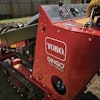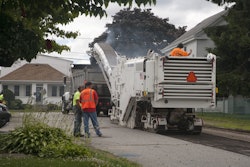On April 4, the American Road & Transportation Builders Association (ARTBA) filed suit in the 5th U.S. Circuit Court of Appeals to thwart the Occupational Safety & Health Administration’s (OSHA) final regulation for exposure to crystalline silica.
“OSHA’s silica regulation is based on flawed science, flawed economic data and flawed logic,” Pete Ruane, ARTBA President, said. “The unintended consequence of the proposal is that it will actually expose road workers to greater risk by diverting resources away from other legitimate safety programs.”
ARTBA: OSHA Silica Proposal Could Increase Risks for Road Construction Workers
Crystalline silica is a basic component of dust from soil, sand, granite and other minerals associated with construction. The rule, released March 24 by the Department of Labor, sets the limit of 50 micrograms per cubic meter of air, averaged over an eight-hour shift, compared to the previous level of 250 micrograms for the construction industry.
ARTBA says OSHA’s standard could divert significant resources — human and financial — away from activities aimed at mitigating, if not eliminating, documented, serious hazards to workers' health and safety such as runovers and backovers and work zone intrusions.
Throughout the rulemaking process, ARTBA has pointed out a number of problems with the new OSHA standard, noting:
- It is based on outdated health data. In setting the new standard, OSHA has relied on studies from as early as the 1930s. More recent data clearly shows silica exposure has been dramatically reduced under the existing standard. According to the Center for Disease Control (CDC), deaths due to silicosis have declined 93% over the past 39 years.
- It is built on faulty economic data. OSHA estimates the rule will cost the construction industry $658,971,248 per year. An ARTBA co-sponsored, independent economic analysis of the proposed standard, conducted by Environomics, Inc., shows the new standard will cost the construction industry nearly $2.2 billion per year.
- It may be doing more harm than good by requiring workers to wear respirators in hot environments, potentially exposing them to otherwise avoidable heat stroke and stress.
- It creates air sampling requirements that are unworkable, requiring time consuming sampling and testing procedures that will yield virtually meaningless results, since, by the time the results are known, the “workplace” location and conditions tested will have moved and/or changed.
Despite ARTBA’s numerous attempts to have these concerns addressed by OSHA during the rulemaking process, the agency ignored them in the final rule, ARTBA said.




![[VIDEO] Understanding Crystalline Silica Hazards](https://img.forconstructionpros.com/files/base/acbm/fcp/image/2015/10/default.561e6d1e51572.png?auto=format%2Ccompress&fit=crop&h=167&q=70&w=250)










